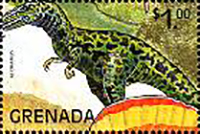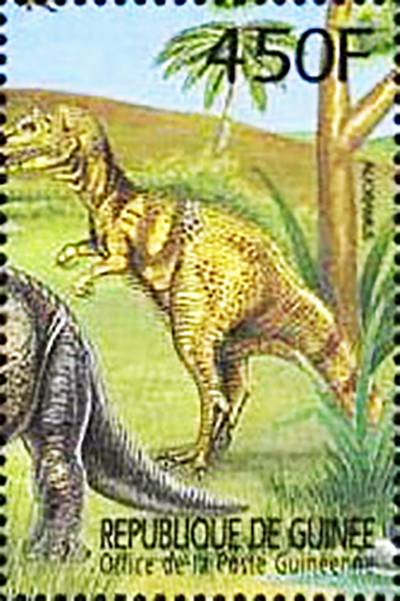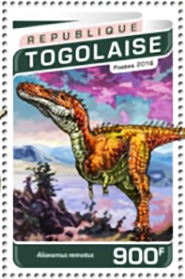Alioramus remotus Kurzanov, 1976

Phylum: Chordata Haeckel, 1874
Subphylum: Vertebrata Cuvier, 1812
Classe: Dinosauria Owen, 1841
Ordine: Saurischia Seeley, 1887
Famiglia: Tyrannosauridae Osborn, 1906
Genere: Alioramus Kurzanov, 1976
Descrizione
I resti sono tuttavia limitati a un singolo cranio, per di piů incompleto, il cranio dell'animale si presenta particolarmente lungo e basso, con una serie di carene ossee nella zona tra le narici e le orbite. L'alioramo č stato riconosciuto come una forma di tirannosauridi, i grandi dinosauri teropodi che occupavano il ruolo di superpredatori nel Cretaceo del Laurasia. Al contrario della maggior parte dei rappresentanti di questo gruppo, l’Alioramus (il cui nome significa “altro ramo”) non era particolarmente grosso: la lunghezza complessiva doveva aggirarsi sui 6 metri, e il peso raggiungeva forse i 750 chilogrammi. I denti, presenti in numero maggiore di quelli di solito presenti nelle fauci degli altri “tiranni”, erano lunghi, curvi e seghettati. Un animale a esso simile era l’Alectrosaurus.
Diffusione
Dinosauro carnivoro scoperto nei terreni del Cretacico superiore in Mongolia.
Bibliografia
–Carr, Thomas D.; Varricchio, David J.; Sedlmayr, Jayc C.; Roberts, Eric M.; Moore, Jason R. (2017). "A new tyrannosaur with evidence for anagenesis and crocodile-like facial sensory system". Scientific Reports. 7: 44942.
–Junchang Lü; Laiping Yi; Stephen L. Brusatte; Ling Yang; Hua Li; Liu Chen (7 May 2014). "A new clade of Asian Late Cretaceous long-snouted tyrannosaurids". Nature Communications. 5 (3788): 3788.
–Kurzanov, Sergei M. "A new carnosaur from the Late Cretaceous of Nogon-Tsav, Mongolia". The Joint Soviet-Mongolian Paleontological Expedition Transactions (in Russian). 3: 93-104.
–Holtz, Thomas R. (2004). "Tyrannosauroidea". In Weishampel, David B.; Dodson, Peter; Osmólska, Halszka (eds.). The Dinosauria (Second ed.). Berkeley: University of California Press. pp. 111–136. ISBN 978-0-520-24209-8.
–Currie, Philip J. (2000). "Theropods from the Cretaceous of Mongolia". The Age of Dinosaurs in Russia and Mongolia. Cambridge: Cambridge University Press. pp. 434-455. ISBN 978-0-521-54582-2.
–Hurum, Jřrn H.; Sabath, Karol (2003). "Giant theropod dinosaurs from Asia and North America: Skulls of Tarbosaurus bataar and Tyrannosaurus rex compared". Acta Palaeontologica Polonica. 48 (2): 161-190.
–Currie, Philip J. (2003). "Cranial anatomy of tyrannosaurids from the Late Cretaceous of Alberta". Acta Palaeontologica Polonica. 48 (2): 191-226.
–Norell, Mark A.; Balanoff, Amy M.; Brusatte, Stephen L.; Bever, Gabe S. (2011-08-10). "Variation, Variability, and the Origin of the Avian Endocranium: Insights from the Anatomy of Alioramus altai (Theropoda: Tyrannosauroidea)". PLOS One. PLOS Collections. 6 (8): e23393.
–Brusatte, Stephen L.; Carr, Thomas D.; Erickson, Gregory M.; Bever, Gabe S.; Norell, Mark A. (2009). "A long-snouted, multihorned tyrannosaurid from the Late Cretaceous of Mongolia". Proceedings of the National Academy of Sciences of the United States of America. 106 (41): 17261-6.
–Currie, Philip J.; Hurum, Jřrn H; Sabath, Karol (2003). "Skull structure and evolution in tyrannosaurid phylogeny". Acta Palaeontologica Polonica. 48 (2): 227-234.
–Carr, Thomas D.; Williamson, Thomas E.; Schwimmer, David R. (2005). "A new genus and species of tyrannosauroid from the Late Cretaceous (middle Campanian) Demopolis Formation of Alabama". Journal of Vertebrate Paleontology. 25 (1): 119-143.
–Maleev, Evgeny A. (1955). "New carnivorous dinosaurs from the Upper Cretaceous of Mongolia". Doklady Akademii Nauk SSSR (in Russian). 104 (5): 779-783.
–Currie, Philip J. (2003). "Allometric growth in tyrannosaurids (Dinosauria: Theropoda) from the Upper Cretaceous of North America and Asia". Canadian Journal of Earth Sciences. 40 (4): 651-665.
–Loewen, M.A.; Irmis, R.B.; Sertich, J.J.W.; Currie, P. J.; Sampson, S. D. (2013). Evans, David C (ed.). "Tyrant Dinosaur Evolution Tracks the Rise and Fall of Late Cretaceous Oceans". PLoS ONE. 8 (11): e79420.
–Jerzykiewicz, Tomasz; Russell, Dale A. (1991). "Late Mesozoic stratigraphy and vertebrates of the Gobi Basin". Cretaceous Research. 12 (4): 345-377.
–Osmólska, Halszka (1997). "Nemegt Formation". In Currie, Philip J.; Kevin Padian (eds.). The Encyclopedia of Dinosaurs. San Diego: Academic Press. pp. 471-472. ISBN 978-0-12-226810-6.

|
Data: 01/09/1999
Emissione: Dinosauri Stato: Grenada |
|---|

|
Data: 12/08/1999
Emissione: Fauna preistorica Stato: Guinea |
|---|

|
Data: 15/12/2016
Emissione: I dinosauri Stato: Togo Nota: Emesso in un foglietto di 4 v. diversi |
|---|